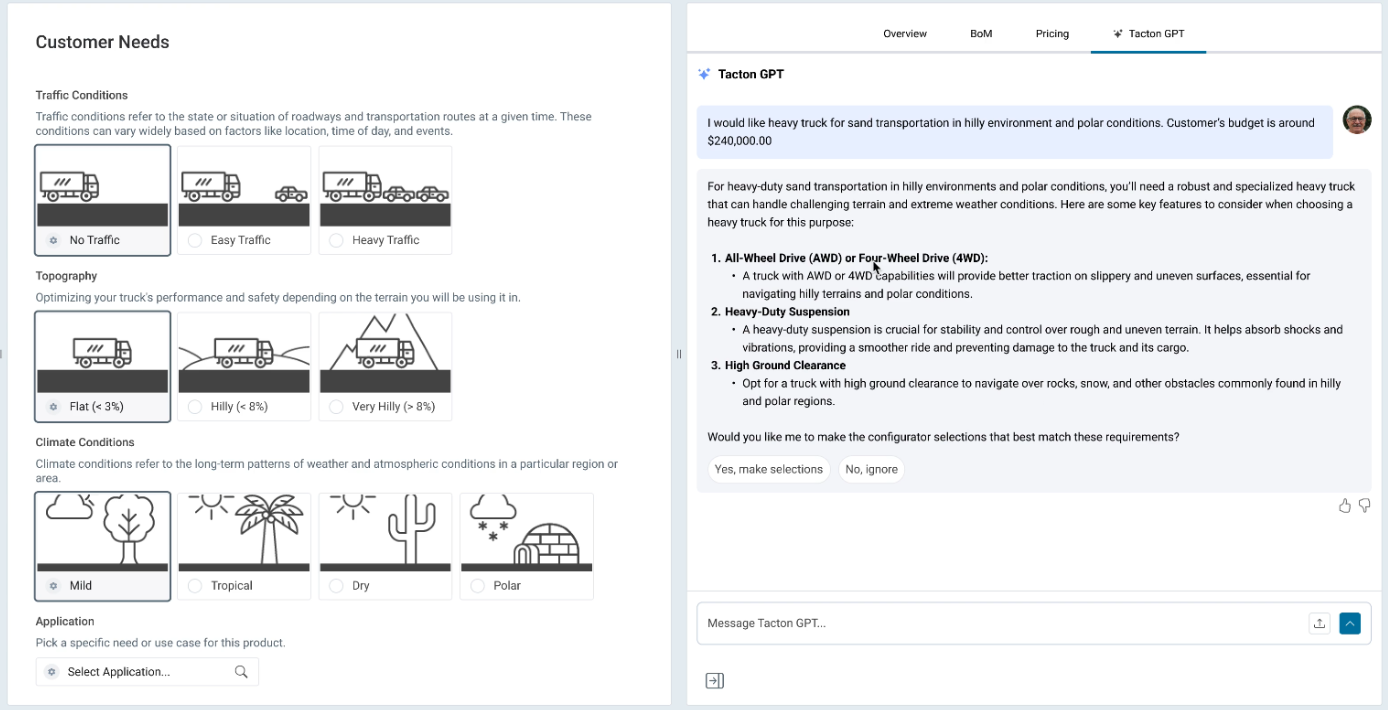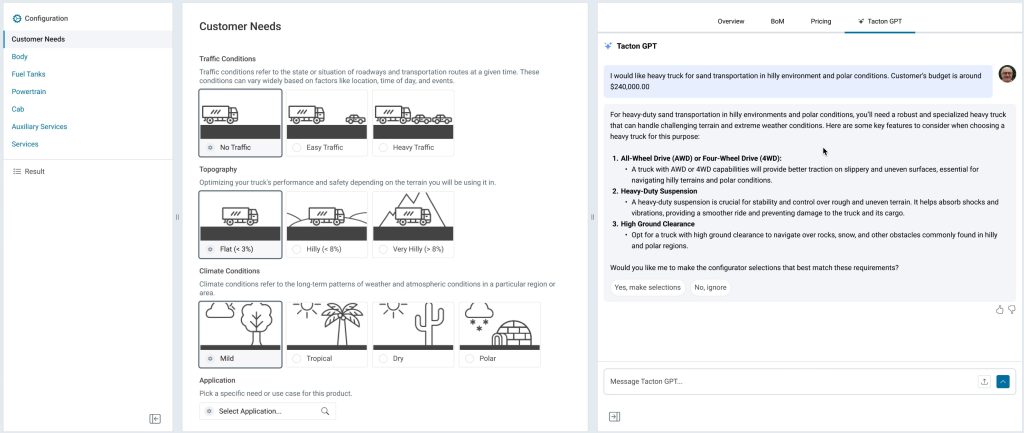Tacton’s Next Gen Approach with AI for Manufacturing Sales
AI for B2B manufacturing is here to stay. Find out how Tacton is using AI to simplify the quoting and selling process.

Why is AI urgent in the B2B manufacturing sales process?
As we stand on the brink of a new era in manufacturing, the integration of Artificial Intelligence (AI) into the sales process presents an unprecedented opportunity for innovation and growth. With 75% of advanced manufacturing companies prioritizing AI technologies, the industry is poised for a significant leap forward. AI’s role in enhancing productivity across the value chain—from procurement and maintenance to logistics—is becoming increasingly evident.
Both B2B buyers and sellers are becoming digital natives. Buyers expect the buying process to be instant and reliable, pushing manufacturers to adopt digital sales automation technologies that can make the buying journey smooth, fast, and flawless – for both parties. Smart configuration–pricing–quoting technologies can bridge the gap between buyers’ digital purchasing expectations and the sales methods used by traditional manufacturing companies. Generative AI has the power to boost this transition.
We also see how product differentiation and value-based selling become more critical to winning deals. Buyers expect manufacturers to offer products that are unique to their use case and to present the business value created – already early in the buying journey. In a world like this, the day-to-day sales tasks of requirements collection, solution definition, quote generation and order taking need to be faster and more automated so that the sales rep can focus the sales discussion on value creation rather than shuffling emails about technical features. Tacton CPQ’s award-winning sales automation solution already helps B2B manufacturers in this vein, but generative AI opens completely new possibilities to further reinforce this.
Boosting Tacton CPQ with Generative AI – our vision
Our journey towards incorporating AI into Tacton’s CPQ solutions is driven by a desire to empower manufacturers with selling and buying tools that are not just about automation but smart, strategic decision-making.
Tacton’s long-term approach to AI is grounded in the following principles:
- Careful evaluation of use cases, separating AI hype from business value. Focus on areas where AI can have the most impact, avoiding the risk of meaningless or even inaccurate responses.
- Co-innovation with customers. As a part of our continuous and ongoing discussions with our esteemed customers, AI use cases will be presented, discussed, and developed based on their business needs. This will also ensure that we separate hype from business value.
- Evolving portfolio. As we will see, AI can be used in multiple parts of the sales and product introduction process. Tacton will gradually release capabilities, listening and learning from those while moving to the next feature.
- Safe, secure, and compliant – for business and user. Training AI models can be performed on different types of data sets, e.g. public data (e.g. Tacton Help Center content) or customer-specific data and logic (residing in the specific CPQ tenants used by one Tacton customer). Tacton will always respect the integrity of our customer’s data and we need to be very clear to everyone involved how AI will be trained.
- Future proof – model agnostic, pluggable architecture. During its 26+ years of existence, Tacton has taken great pride in being integration-agonistic to other enterprise systems such as ERP, CRM, CAD, and PLM. This principle will apply also to AI platforms. Whatever AI integrations we do, needs to be flexible and expandable to accommodate the shifting enterprise software landscape of our clients.
To continue being the leader in CPQ, Tacton is investing in developing its SaaS CPQ to incorporate Gen AI and Machine Learning technologies in the following two areas:
Make selling and buying easier and faster
- Increase speed and accuracy in sales. Sales reps and buyers can use natural language configuration or an RFQ document for fast and valid product selection and accelerate sales quote production. Help your sales reps quote on customer needs accurately (see mockup image).

- Price Optimization. Based on win-loss analysis of past similar deals, guide the sales rep in the best price points to maximize both deal profitability and win rate.
Decrease maintenance costs for CPQ system ownership
- Help Center chatbot. Avoid having to search for support articles on how to work with Tacton administration. Use a conversational bot to refine questions and answers more effectively, reducing the time to value for your CPQ administrators.
- Admin Assistants. Based on the AI model of Tacton CPQ’s help center and customer-specific data in the CPQ environment, Administrators can get snippets of code, formulas, and expressions to extend the capabilities of the customer’s implementation of Tacton CPQ. This can also include best practices in product and pricing modeling.
- Auto Translations. Automatic translation of UI text, product descriptions, and quotes, avoiding misunderstandings and errors.
- Model Optimization. Ask and receive model optimization recommendations in natural language immediately to ensure higher quality and performance.
Looking Ahead: A Strategic Partnership for Innovation
For executives contemplating the future of their sales processes, Tacton’s forward-looking approach offers a beacon of innovation and growth. By aligning with Tacton, companies can:
- Prepare for the integration of AI-driven efficiencies into their sales process.
- Anticipate a future where sales cycles are accelerated, and productivity is maximized.
- Look forward to enhanced customization and customer engagement through intelligent analysis & recommendations.
Be a part of the future today. Reach out to Tacton to learn more about our vision for AI-driven manufacturing sales and how we can help prepare your business for the innovations ahead.
Tacton Forward-Looking statement
- Some services or features referenced in connection with this presentation may not have been released and are not currently available.
- The final product may differ from what is described here
- The target release date is not set and may change due to other priorities. The delivery of the final service or feature may be delayed or not take place at all.
- Customers who purchase our services should make purchase decisions based on features that are currently available.



